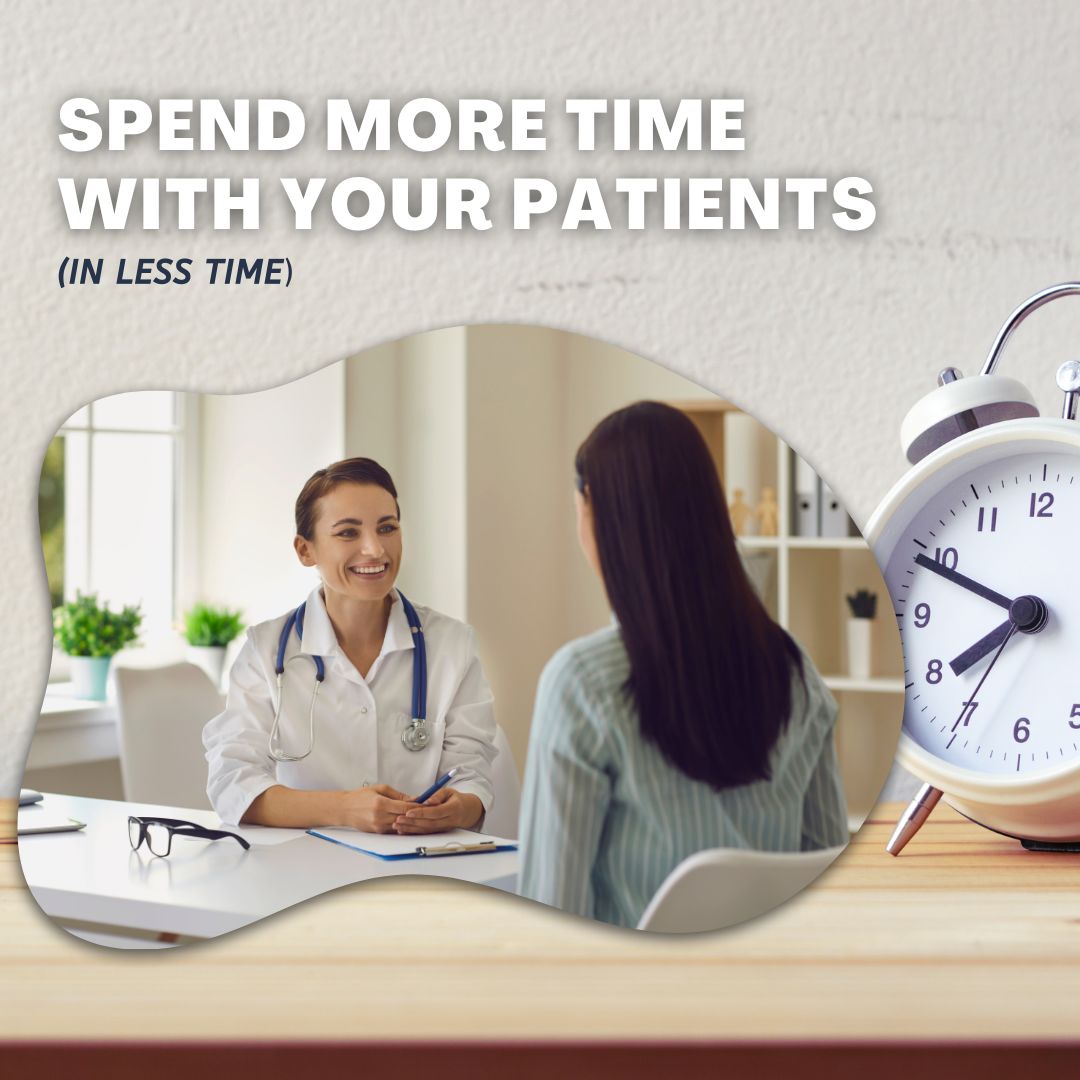How to Spend More Time with Patients and Provide Better Care

Are you looking to spend more time with patients? As a medical professional, you are committed to providing the best possible care for your patients. However, one pressing issue that continues to hinder the doctor-patient relationship is the lack of sufficient time and attention you’re able to give to patients during appointments. In this article we’ll discuss how to give patients the time and attention they deserve, without causing you to work harder than you already are.
The Problem: Providers Can’t Give Patients Enough Attention
It’s no secret to you or your patients that you’re pressed for time. While you’d love to give your patients all the time and energy you have, it’s simply not possible. Doctors, nurses and other practitioners just like you, often find themselves grappling with time constraints, leaving them with less and less time to spend with each patient. Numerous studies have highlighted this problem, revealing that healthcare providers are spending significantly less time with patients than in the past. While this is par for the course, it doesn’t serve you or your patients.

The Challenge: Limited Time and Burnout Among Physicians
Recent data reveals that most U.S. physicians spend an average of 13 to 24 minutes with their patients during office visits. Alarmingly, approximately one in four doctors spend less than 12 minutes with patients, while only about one in ten extend consultations beyond 25 minutes [1]
In another study, researchers found that the median length of office visits was 15.7 minutes, covering an average of six topics during the consultation. However, a very limited amount of time was dedicated to each topic, with the longest receiving approximately 5 minutes, while the remaining topics received only 1.1 minutes each [2]. This disparity highlights the challenges physicians face when trying to address patients’ multiple health concerns in a constrained time frame.
Patients are quick to joke that providers don’t spend enough time with them, but one human being can only do so much. Studies show that over half of physicians in the United States experience symptoms of burnout. This rate is nearly double that of professionals in other industries, even after accounting for factors such as hours worked, age, and sex [3]. Burnout can negatively impact a physician’s well-being, leading to reduced job satisfaction, decreased empathy, and even errors in patient care.
The Solution: Saving Time and Caring for More Patients Using Technology
Seeing more patients and plugging into their real needs, while also exerting less time and effort, doesn’t just seem like a paradox, it actually sounds unrealistic. Until, you consider the power of technology.
In 2023 just about everything is automated. So why can’t some of your care be? To address the issue of inadequate time and attention in doctor-patient interactions, the BodySite remote patient care platform presents a promising solution. This innovative technology leverages patient engagement tools to enhance communication and streamline care delivery.
Patients often want guidance and answers to their questions, many of which are common and easily addressable using BodySite. Here are just a few tools you can leverage on BodySite to address patient concerns and even automate aspects of their care:
Automated Care Plans: The platform allows doctors to prescribe automated care plans for each patient in a few clicks. Once enrolled patients will have a plan that is 30, 60, 90 days or longer, filled with interactive, educational content that can help them with their specific health concern. Patients can access these plans, monitor progress, and stay engaged in their care journey.
Virtual Visits: With BodySite, providers can conduct virtual visits via BodySite’s native telehealth technology, enabling you to reach patients beyond in-between office visits. This flexibility not only saves time but also caters to patients who may have difficulty traveling to your office.
Secure Messaging: BodySite offers a secure messaging feature that fosters seamless communication between doctors and patients. Patients can ask questions, seek clarifications, and share updates, promoting a more collaborative and satisfying healthcare experience.
Patient Data Syncs Automatically: BodySite empowers patients to track their health metrics easily through food, biometric data and activity tracking. BodySite also seamlessly integrates wearable devices and health monitoring tools. All this information is available to you inside the patient record, so you can get an instant snapshot of how your patient is doing. You can access this real-time data, enabling you to make informed decisions during consultations.
(Coming Soon) Scheduling: BodySite will soon be launching a native scheduling feature available for providers and their care team to access. This calendar will help providers to manage their appointments for work, personal and also block off time when unavailable. Sync your existing calendar or use it by itself!
The BodySite remote patient care platform offers doctors the tools they need to provide high-quality care while fostering a stronger connection with their patients without causing you to exert even more effort than you already are. Providers who use the BodySite platform have boasted that they have happier patients and more time. If you’re not already a BodySite subscriber consider trying us out. Claim your no obligation 30 Day Free Trial HERE.
Sources:
- Franklin, R. (2021, October 9). Are doctors spending less time with patients?. Mobius MD. https://mobius.md/2021/10/09/how-much-time-do-physicians-spend-with-patients/#:~:text=A%20review%20of%202018%20data,spend%20more%20than%2025%20minutes.
- Tai-Seale M, McGuire TG, Zhang W. Time allocation in primary care office visits. Health Serv Res. 2007 Oct;42(5):1871-94. doi: 10.1111/j.1475-6773.2006.00689.x. PMID: 17850524; PMCID: PMC2254573.
-
Reith TP. Burnout in United States Healthcare Professionals: A Narrative Review. Cureus. 2018 Dec 4;10(12):e3681. doi: 10.7759/cureus.3681. PMID: 30761233; PMCID: PMC6367114.
